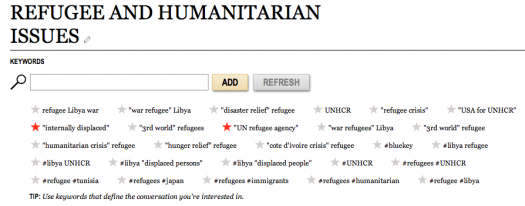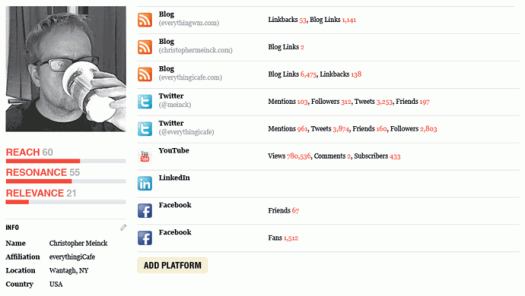
There’s a lot of discussion these days around influencers. With the proliferation of social media, it’s no longer just about generating the conversations online, but now it’s also about who’s talking about you and what they’re saying. It can be helpful to keep tabs on those influencers so that you can engage with them, as well as get feedback on your work.
This is where Traackr comes in. I received a three-month trial of the system and have been using it to gauge traction for the Blue Key campaign.
Much has already been written about the benefits of Traackr. If you haven’t read them, I’m pointing you to some great posts by Valeria Maltoni and Rick Liebling.
The main reason I’m a huge fan of the service is because with Traackr, it’s not about numbers, or how much you talk to someone on Twitter all day. It’s about context, relevance and therefore potential influence based on that contextual relevance. So you could, for example, have someone who is not very active on Twitter or Facebook but has a blog that is devoted to refugee and humanitarian issues. That’s someone I probably want to keep track of — and that’s the kind of thing Traackr lets me do.
You should know up front that Traackr is not cheap. It costs about $500 if you’re signing up for a list as a new account, and then the prices per list goes down. I was told that the founder may be considering alternative prices for small businesses, nonprofits or indie pros, but no word yet on when that will be.
How to use Traackr
Start out by identifying a particular area or topic that you’re trying to find online influencers in. For example, for the Blue Key campaign, one of my searches focused on refugees and humanitarian issues, i.e. people who are active online and who post frequently to any number of online channels about those issues.Once you’ve identified these topic areas, make a list of keywords relevant to that topic area. You can set up to 50 keywords per search. As you’re doing so, Traackr will tell you how broad or niche that keyword is. You can also include Twitter hashtags and prioritize keywords. For example, here are the keywords I’d set up for this particular search (refugee and humanitarian issues):

Once you’re satisfied with your list of keywords (you can test them as you go; Traackr automatically generates a list based on who in its database is using those keywords most frequently), you can activate your search. Then, Traackr starts crawling the Web based on your keywords.
When it’s had a few days to do so, it will give you an updated list of influencers based not simply on how active they are on Twitter or Facebook, but on how much they use those terms in as many of their digital properties as they’ve been able to identify. If you find that the Traackr database is missing one or more of their digital properties can add a property and once Traackr verifies it, it will be added to that influencer’s profile.
Traackr updates your influencer list on a weekly basis, and the list changes based on how frequently those on your list have been using your keywords. So it’s an active search, not a passive one.
5 ways to make Traackr work for you
1 Traackr gives you an “A-list” of 25 people who are using your keywords the most. That A-list is what changes on a weekly basis, based on how frequently they are using your keywords. If you want to add more than 25 influencers to your list you can, but that will cost you.How much, I don’t know, so you should try it out and see if that list of 25 is giving you what you need before you try to extend it (you can delete people if you decide they’re not relevant for you).
2 You can change your keywords as you need to, but I would suggest you spend a lot of time putting together your initial list (their customer service is terrific and will help you review them). Then activate your search when you think your list of keywords is really solid.
3 Traackr won’t give you an “influencer score.” Derek Skaletsky, who works with the company (and who is also, coincidentally, the creator of Propz), made this very clear in a recent blog post. Yes, it will give you a list of people who use those keywords most frequently, and they will be ranked on your list based on that frequency, but it’s nothing like a Klout score.
4 The list won’t do your work for you. Just like you need to make sure your PR pitches don’t suck, you need to take the list for what it is – a starting point for you to identify people who are active online (and we all know the difference between being active online and offline, right?) in the area you’re interested in, so that you can start to build relationships with them and move your campaign ahead.
5 As of now, you can’t segment influencers by geography. However, if you are focusing on a particular geographic area, look carefully at their “footprint” in Traackr and delete those who aren’t relevant to your search (see example below).

Because of the way Traackr focuses on topics rather than simply activity on Twitter and Facebook, I think it’s a real winner.
Source
Have you tried Traackr? If so, what do you think? Are there other influence tools you’ve found useful? Please share in the comments in the box below.

No comments:
Post a Comment